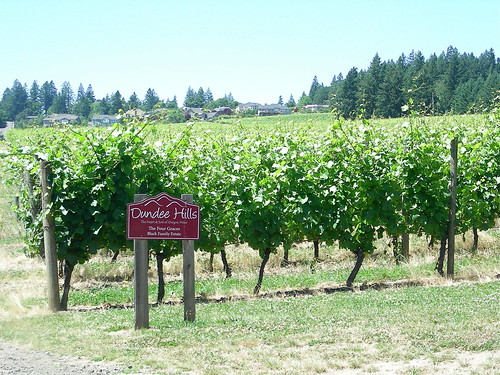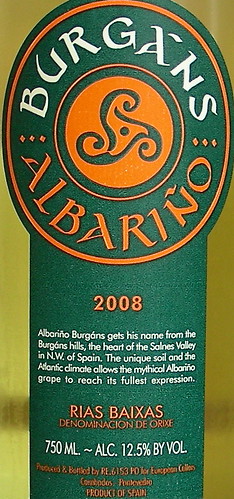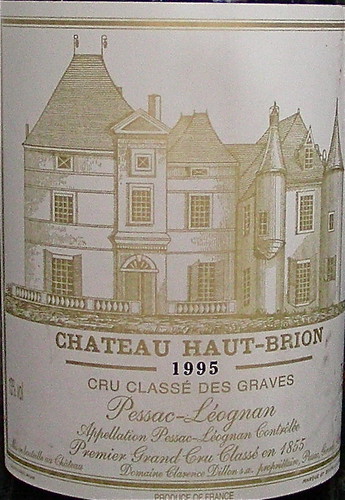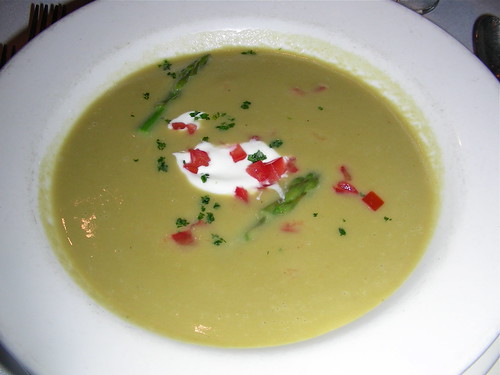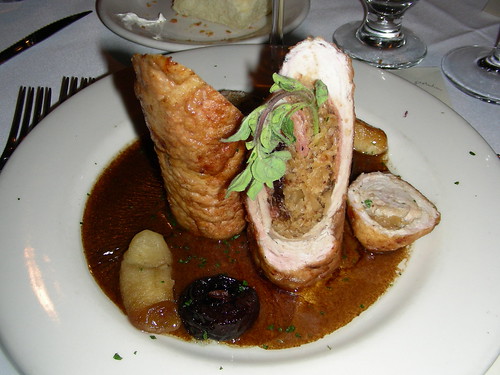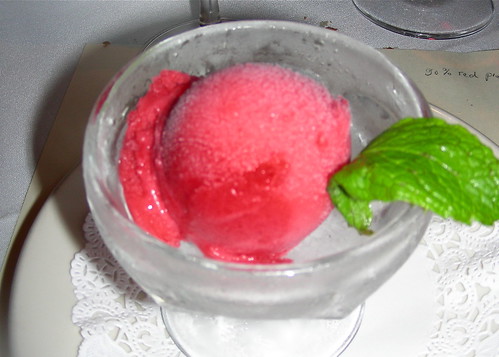Ponzi Vineyards is one of Oregon's oldest wineries. It was founded in 1970 at a time when Oregon was not a well-known wine region and when making Pinot Noir in the Willamette Valley was rather risky. Nowadays, Ponzi has become a successful winery dedicated to sustainable viticultural and enological practices. It is was one of the first Oregon property to get the LIVE Winery Certification. A new eco-friendly winemaking facility was completed for the 2008 harvest. Built atop one of the Chehalem Mountains slopes, it uses several green features including gravity-flow processing, temperature control, energy efficient lights, natural ventilation, water retention, and recycling.
It was a hot day and we wanted to start with something fresh and crisp, so following the advice of Sales Associate Kendra Wells, we ordered a flight of mostly white wines. Here are my notes:
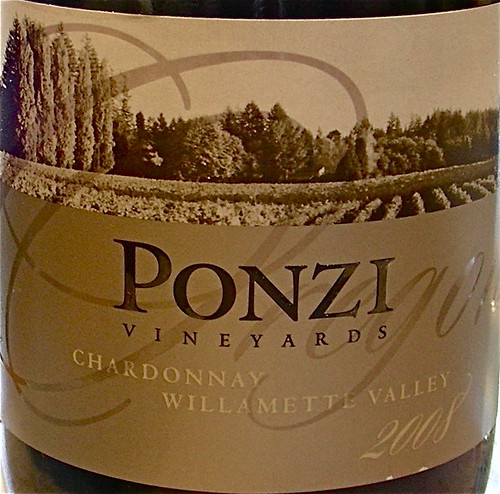 • 2008 Ponzi Chardonnay Willamette Valley: produced from old vine Chardonnay, the wine was hand sorted, whole cluster pressed and fermented in 100% stainless steel. My notes: stone fruit and butterscotch aromas on the nose, crisp, light to medium-bodied on the palate, fresh and lively on the finish.
• 2008 Ponzi Chardonnay Willamette Valley: produced from old vine Chardonnay, the wine was hand sorted, whole cluster pressed and fermented in 100% stainless steel. My notes: stone fruit and butterscotch aromas on the nose, crisp, light to medium-bodied on the palate, fresh and lively on the finish.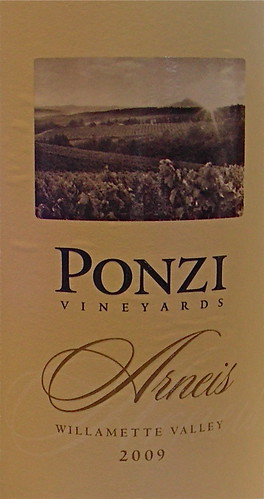 • 2009 Ponzi Arneis Willamette Valley: Arneis is a white wine varietal from the Piedmont region in Northern Italy. Ponzi Vineyards is one of very few U.S. producers of Arneis and the only producer in Oregon. The wine was fermented at very low temperatures in stainless steel with a portion in neutral oak. My notes: floral aromas on the palate, fizzy and light on the palate, good acidity, light finish.
• 2009 Ponzi Arneis Willamette Valley: Arneis is a white wine varietal from the Piedmont region in Northern Italy. Ponzi Vineyards is one of very few U.S. producers of Arneis and the only producer in Oregon. The wine was fermented at very low temperatures in stainless steel with a portion in neutral oak. My notes: floral aromas on the palate, fizzy and light on the palate, good acidity, light finish.• 2009 Ponzi Pinot Blanc Willamette Valley: Pinot Blanc is a genetic mutation of Pinot Noir and produces full-bodied white wines in Alsace, Germany, Luxembourg, Italy, Hungary, Czech Republic and Slovakia. In Oregon, it is known as the real thing because Oregon's cuttings came originally from Alsace, whereas in California, the certified Pinot Blanc rootstock from University of California at Davis turned out to be Melon de Bourgogne, a grape from the Loire Valley used in Muscadet. The wine was fermented 75% in stainless steel tanks, 25% in neutral oak barrels with partial malolactic fermentation. My notes: aromatic nose, floral notes, rather dry, crisp, mineral finish.
 • 2009 Ponzi Pinot Gris Willamette Valley: Pinot Gris is a clone of Pinot Noir with a different skin color that was caused by a genetic mutation. It is known to be Oregon's Signature White Wine. It was David Lett from The Eyrie Vineyards that planted the first Pinot Gris vines in Oregon in 1966. At Ponzi, Pinot Gris plantings started in 1978. My notes: attractive nose of white peach, medium body, spicy, mineral finish. Drier than most of the Oregon Pinot Gris wines that we have tasted so far.
• 2009 Ponzi Pinot Gris Willamette Valley: Pinot Gris is a clone of Pinot Noir with a different skin color that was caused by a genetic mutation. It is known to be Oregon's Signature White Wine. It was David Lett from The Eyrie Vineyards that planted the first Pinot Gris vines in Oregon in 1966. At Ponzi, Pinot Gris plantings started in 1978. My notes: attractive nose of white peach, medium body, spicy, mineral finish. Drier than most of the Oregon Pinot Gris wines that we have tasted so far.We also tasted a flight of two “guest” (non Ponzi) wines:
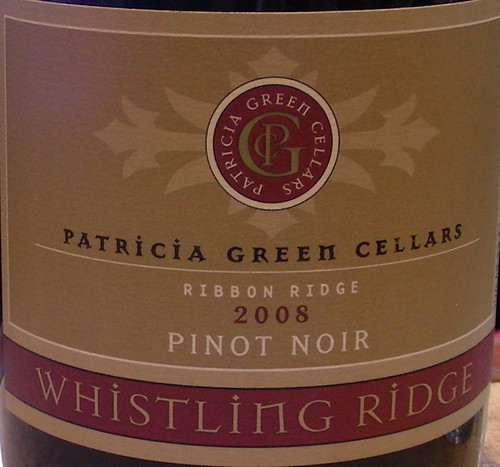 • 2008 Patricia Green Pinot Noir Whistling Ridge: Patricia Green Cellars is located in the Ribbon Ridge district of Yamhill County. Whistling Ridge Vineyard is a small, 15-year old vineyard in the Ribbon Ridge appellation, located just behind Patricia Green Cellars and Beaux Frères Vineyards. My notes: funny chemical on the nose, notes of tar, butterscotch. Not our favorite.
• 2008 Patricia Green Pinot Noir Whistling Ridge: Patricia Green Cellars is located in the Ribbon Ridge district of Yamhill County. Whistling Ridge Vineyard is a small, 15-year old vineyard in the Ribbon Ridge appellation, located just behind Patricia Green Cellars and Beaux Frères Vineyards. My notes: funny chemical on the nose, notes of tar, butterscotch. Not our favorite.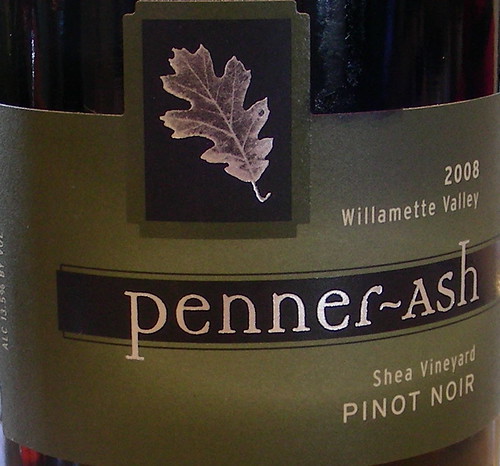 • 2008 Penner-Ash Pinot Noir Shea Vineyard: founded in in 1998 by winemaker Lynn Penner-Ash and her husband Ron, Penner-Ash Wine Cellars is located on the eastern edge of the Yamhill-Carlton District. Owned by Dick and Deidra Shea, Shea Vineyard was one of the early planted vineyards in Yamhill County. It is a 200-acre property with 135 planted to Pinot Noir and 5 acres planted to Chardonnay. While the Shea family keeps 25% of the Pinot Noir for their own bottling, the rest is sold to various wineries in Oregon and California. My notes: nose of sweet berries with notes of green pepper, earthy on the palate with a hint of caramelized pear on the finish.
• 2008 Penner-Ash Pinot Noir Shea Vineyard: founded in in 1998 by winemaker Lynn Penner-Ash and her husband Ron, Penner-Ash Wine Cellars is located on the eastern edge of the Yamhill-Carlton District. Owned by Dick and Deidra Shea, Shea Vineyard was one of the early planted vineyards in Yamhill County. It is a 200-acre property with 135 planted to Pinot Noir and 5 acres planted to Chardonnay. While the Shea family keeps 25% of the Pinot Noir for their own bottling, the rest is sold to various wineries in Oregon and California. My notes: nose of sweet berries with notes of green pepper, earthy on the palate with a hint of caramelized pear on the finish.While we were tasting, Kendra recommended going to Beaux Frères and she even called the tasting room for us. I remembered buying two bottles of their Pinot Noir some time ago but I hadn't tried them yet, so it was time to move on and discover the wines of Beaux Frères.
Technorati tags: wine food & drink
